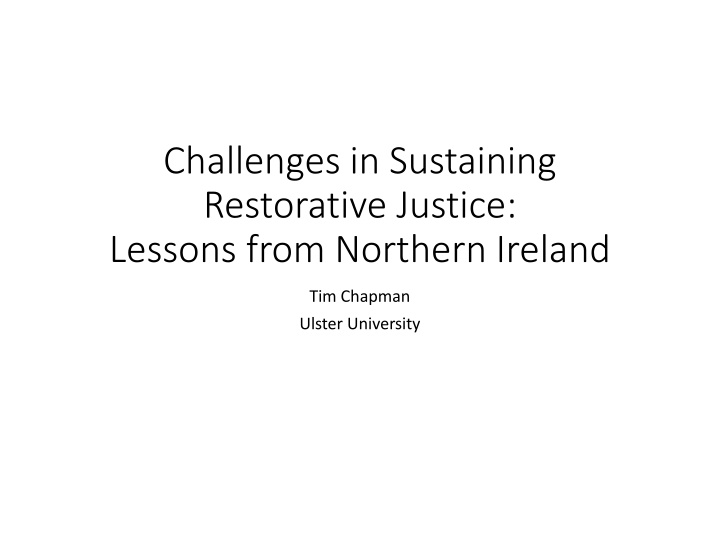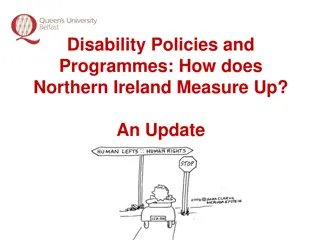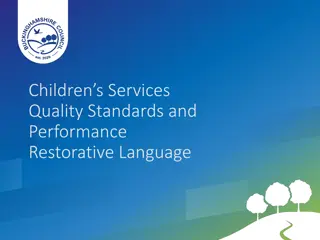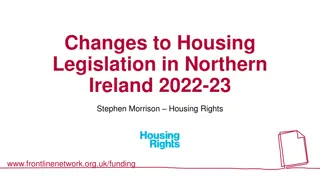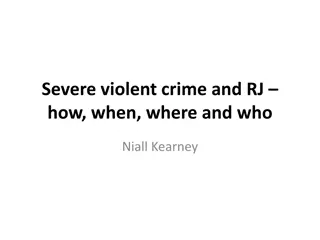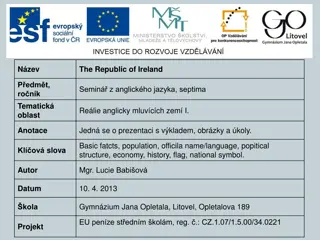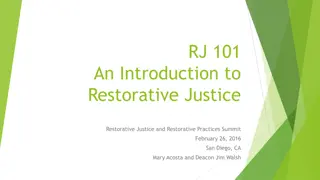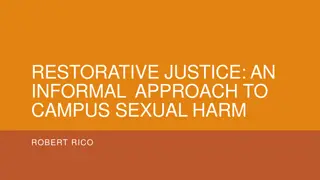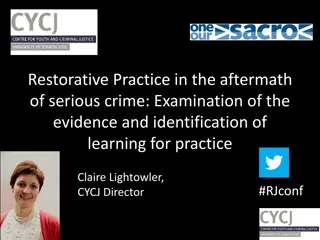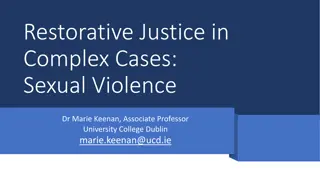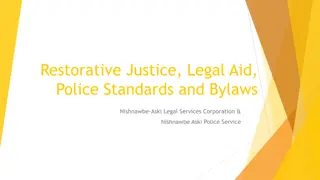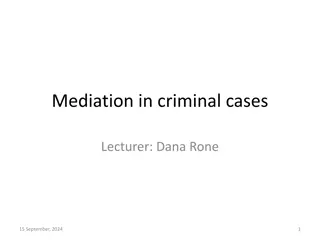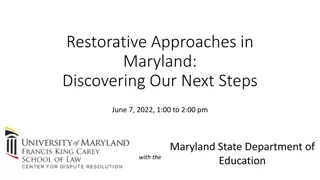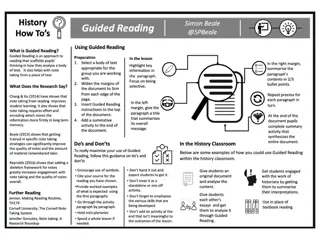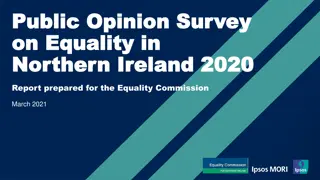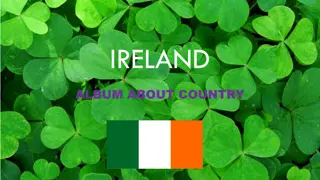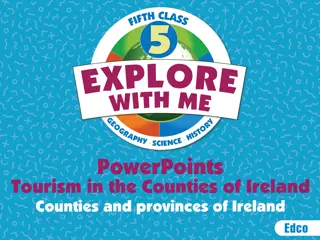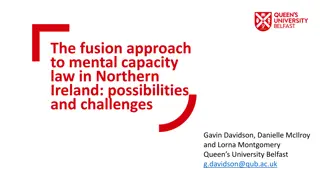Challenges in Sustaining Restorative Justice: Lessons from Northern Ireland
Restorative justice in Northern Ireland, set up through mandatory laws in 2002, has shown promising outcomes with over 20,000 youth conferences and high levels of victim satisfaction. However, there are struggles with institutional needs overshadowing the primary goals of service and the potential drift towards managerialism and legalism, raising questions about the sustainability and effectiveness of the restorative justice system.
Download Presentation

Please find below an Image/Link to download the presentation.
The content on the website is provided AS IS for your information and personal use only. It may not be sold, licensed, or shared on other websites without obtaining consent from the author.If you encounter any issues during the download, it is possible that the publisher has removed the file from their server.
You are allowed to download the files provided on this website for personal or commercial use, subject to the condition that they are used lawfully. All files are the property of their respective owners.
The content on the website is provided AS IS for your information and personal use only. It may not be sold, licensed, or shared on other websites without obtaining consent from the author.
E N D
Presentation Transcript
Challenges in Sustaining Restorative Justice: Lessons from Northern Ireland Tim Chapman Ulster University
Northern Ireland: set up The 2002 law makes restorative justice mandatory Restorative conferences bring together all those who have a stake in repairing the harm to the victim and supporting the young person to have a better life. Facilitated by full time practitioners in the Youth Justice Agency trained by Ulster University. Well resourced Strong leadership
The Balanced Model Community Harm Person responsible for harm Injured party Through narrative dialogue
Outcomes for Youth Conferences Number of youth conferences now over 20,000 Over 100,000 people have participated in a youth conference Victim attendance; 50/70% Victim and young person satisfaction ; 90% and 95 26% serious or very serious offences, 53% intermediate, 21% minor 94% successful completion of plans Reoffending 35.4 % (22% for serious harm) Reoffending for all other community disposals 53.5%; for custody 68.3% England and Wales put over twice as many young people into custody as Northern Ireland
On the other hand There is now considerable evidence that institutional needs regularly over-ride the needs of the people that the institution is designed to serve (Pavlich 2009, Hoyle and Rosenblatt 2016, Bolivar 2015, Choi et al 2013, Zernova 2007, Choi and Gilbert 2010, Hoyle et al 2002, Strang 2002, Barnes 2016, Bolivar, Pelikan and Lemonne 2015)
Drift How creating value destroys values Managerialism strategic targets, performance indicators and cost cutting Legalism primacy of the offender, proportionality Quality of delivery and experience become thinner
How can restorative justice be sustainable? Is this the right question?
Fields Society Political and economic systems Institutional context Restorative justice From whose vantage point are we seeing the field?
The fundamental unifying hypothesis of restorative practices is that human beings are happier, more cooperative and productive, and more likely to make positive changes in their behavior when those in positions of authority do things with them, rather than to them or for them.
Integration through assimilation or accommodation? Of what?
What are the major disruptions and disconnections in modern society?
The Problem: Disconnection From nature From others From self
How to engage with social reality in motion? How do we make sense of and respond to the volatility, uncertainty, complexity and ambiguity of the world?
How do we understand, communicate and implement the quality and value of restorative justice?
We can not solve our problems with the same level of thinking that created them Albert Einstein Are we trying to solve today s problems with yesterdays ideas?
Are we in a restorative bubble? How to enable our field to see itself?
The field of restorative practices Elements of traditional communities whose rituals keep the peace; Elements of therapeutic strategies to meet personal needs; Elements of instrumentalist strategies to meet institutional needs; Elements of relational, empathic dialogical processes engaging stakeholders; Elements of collective creativity and action through eco-systems
Eleanour Rooseveldt said: Where, after all, do universal human rights begin? In small places, close to home - so close and so small that they cannot be seen on any maps of the world. Yet they are the world of the individual person; the neighbourhood he lives in; the school or college he attends; the factory, farm, or office where he works. Such are the places where every man, woman, and child seeks equal justice, equal opportunity, equal dignity without discrimination. Unless these rights have meaning there, they have little meaning anywhere. Without concerted citizen action to uphold them close to home, we shall look in vain for progress in the larger world.
What is the source and focus of our attention and listening?
Absence violates restoration Fear, judgement and cynicism Responsibility of the perpetrator Vulnerability of the victim Blaming and excluding Closed mind Echo chamber empathy One truth Denying other truths or lying Closed will One method Closed heart Separation
Presence generates restoration What does it mean to be present? Courage Setting up Showing up Standing up Curiosity Looking out and upwards Knowing you don t know: letting solutions emerge Prepared to have your assumptions and beliefs challenged. Compassion Seeing others suffering Respecting others resilience and intelligence
What is the matter with you? Or What matters to you?
Who decides? Referral Participation Outcomes
Our solution? connect, respect and protect Connect people through their awareness of their participation in society and its impact on others and their awareness that they can act effectively in the common good. Respect is generated through the reintegration of the visible material impact of behaviour and invisible internal processes. Respectful relationships are the most effective means of protecting people from harm.
Whose questions? What questions arise for you out of what happened? What requests do you have?
Listening for the truth through narrative dialogue The facts of the event forensic truth The experience of the event the narrative truth The encounter of the narratives (the whole story) the dialogical truth The generation of new possibilities the transformative truth
Restoring the future An act of harm stimulates a narrative of suffering which interrupts and disrupts one s chosen narrative. Moving from a general public narrative to a specific personal narrative. Moving from the specific personal narrative to a common more complete narrative. Moving on with one s chosen narrative.
A process of opening, deepening, completing and moving on.
Who owns restorative justice? You can t produce RJ. You can t order RJ. You can t buy RJ. You can t shape RJ. You can t own RJ. You can t give RJ. You can only do it and be it.
Who is it who practices restoratively?
Practitioners invisibility and stillness Create the conditions And engage presence And facilitate the process Which lets people attend to harm and suffering So that the outcomes that satisfy them emerge.
Restorative processes as scaffolding Providing strong, safe platforms enabling people to reach dangerous places and facilitating difficult work.
People, even more than things, have to be restored, renewed, revived, reclaimed, and redeemed; never throw out anyone.
Thank you tj.chapman@ulster.ac.uk
